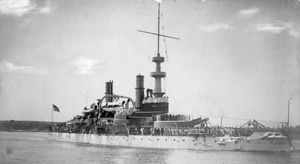Catalogue number 100123
New Navy battleship U.S.S. Massachusetts.
One of the three Indiana class “New Navy” prototype battleships, U.S.S. Massachusetts (laid down 1891) was not the success hoped for, the freeboard being far to low. With maximum bunker capacity and ammunition, the armour belt became ineffective. This problem was compounded by the 8-inch turrets being mounted high up. The 13-inch guns were in covered barbettes.
Verso:Postcard sent to an address in Nantes from Paris, franked 1906
Credit: E. Muller, 1901
14cm x 8.4cm Matt gelatin silver print
|
 |